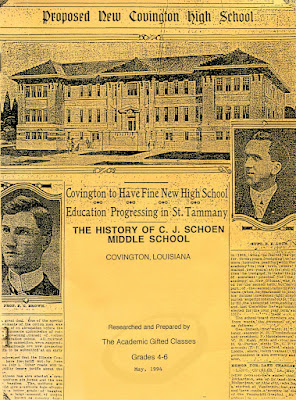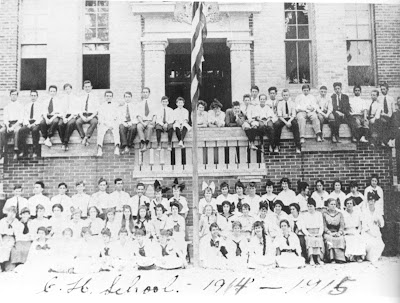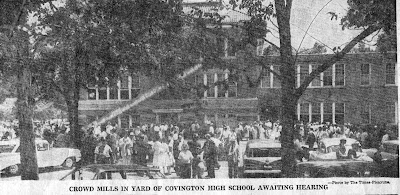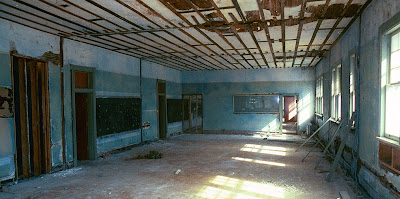C. J. Schoen Middle School History
At the corner of what is now 23rd and Jefferson Avenue, Covington, Louisiana, stands a landmark known to hundreds of people as the first real public school site in the history of St. Tammany Parish. Through research, oral history, and photograph we walk through 80 years of history. Come join us as we stroll down memory lane.
Pre-School Buildings
At the turn of the century, on a city block square piece of property sandwiched between Silver and Gold Streets (23rd and 24th), stood a large wooden pavilion. This primitive building was used for dances and social events of the era. It was nothing but a roof with four walls. Yet it became the stepping stone to what is our famous C. J. Schoen Middle School.
Originally there were many small private schools which dotted the vast expanse of western St. Tammany. Each housed only a few students and seemed to open and close on an amazingly flexible schedule. It was common for a school teacher to reside in various homes of the community, moving from home to home every two or three months throughout the school term. Each community would pay the school teacher's meager $30.00-a-month salary.
The good citizens of Covington were anxious for a community school to be built. After many long and heated meetings during the years of 1901-02, the city fathers were finally convinced the pavilion should be converted into at least four classrooms so the children would have a decent place to be educated.
Miss Schiler, the first principal, was also the third grade teacher as well. The pavilion school went well for four or five years and continued to grow until more classrooms were added.
The people weren't satisfied. They wanted a larger, brick school. At that time, the town supplied the revenue for building schools. Plans were made for a small brick school building to be constructed where the present day flag pole now stands.
In 1907, when the walls of the school were approximately about 3 feet high, the town ran out of money and the contractor went bankrupt. All supplies and materials had to be sold and plans had to be abandoned.
In our school's playground lies a plaque:
Erected A. D. 1907
Dr. C. Z. Williams, Mayor
Andrew W. J. Bryan Architect
I. C. Garber Builder
Stories are told about a water branch that ran down Silver Street. The stream flows by the present day Christ Episcopal Church. That branch still exists. It is now contained in culverts as it continues to run down to the Bogue Falaya River. School children used to play in the ditch and loved to watch it's swollen flow when the city flushed its water tower once a year into this ditch.
Even the "necessities" [privies] bridged the gap, girls on one side, boys on the other. There was no running water for the pavilion school. Drinking water was carried in buckets from a house across the street; everyone drank from the same bucket and dipper.
Times changed. The parish now assumed responsibility for building the schools. The school board was able to officially buy this piece of land for $1000, with the understanding the property would be returned to the city of Covington if it ever ceased being used for a public school.
Covington High School (1914-1926)
In 1914, on this site at the cost of $35,000, a three-story building named Covington High School was built, under the leadership of Mr. Elmer Lyon, the first parish school superintendent. Townspeople bragged about it being the biggest and best school throughout the surrounding parishes.
The main building was erected then, complete with an attached auditorium, stage and theater seats. It housed grades 1-11. (12th grade did not exist.) Grades 1 through 7 were housed in the basement (1st) and 2nds floor. The high school convened on the top floor. Plenty of light flooded the auditorium through huge windows situated at the back and side walls. Today (in 1994) the auditorium is the school gymnasium.
The population of the school that first year was 281 students. School was only in session three or four months out of the year. According to the St. Tammany Farmer, March 21, 1914, Professor W. A. Bynum was the first principal of the the high school.
Covington Grammar School (1926-1958)
The city grew. More space was needed to alleviate the school's overcrowded conditions. The school building bulged in 1924 with 507 attending students. Individual class size approached 50 students per room.
Fortunately by 1926 a new Covington High School (old Lyon High) was completed just a few blocks away on Jefferson Street. That freed our site to become Covington Grammar School, grades 1¬7. [Unfortunately, Lyon High burned down Nov. 11, 1974. It was replaced with what is now William Pitcher Junior High.]
May Day festivals were at their height. Children would practice for weeks to prepare for the May Day festivities. Plays, games, dress up pageantry were in vogue. It was a great honor to be King and Queen of the May court.
The Grammar School is not without its sorrows. A story is told of one principal, a Mr. Beduski, who for some reason had climbed the wooden flag pole to retrieve the flag. While his teacher-wife looked on out her corner class room window, the wooden pole snapped off at the top, toppling the principal to the ground, killing him instantly.
The grips of the Depression produced soup kitchens, one of which was placed in one of our basement corners. Lunch was five cents for those who could afford it. While most of the children went home for lunch, there were a few children who came from outlying districts on wagons or walked long distances to school. Those students stayed for lunch. It was not uncommon to see them bring nothing but a piece of cornbread, or a lonely biscuit to eat for lunch.
By the early 1930's, Mr. S. E. Talley became principal of Covington Grammar School. He had a long and colorful principalship. His tenure lasted until 1959, nearly 30 years. Many things transpired during his leadership. By 1933, the school year had been extended to a full 9-month term. A tuition-paid Kindergarten began in that same year Kindergarten attendance was sparse since few had money to pay for its services.
Numerous childish thrills were produced during the 30's, 40's, and early 50's by children sliding down the great tubular fire escapes that came out of the top floor corner class rooms at each end of the building. Alas, because of liability complications and extensive deterioration, the tubes had to be removed.
Wooden floors were soaked regularly with oil. Female teachers would go home at the end of the day with stains on the hems of their dresses. Class sizes were known to be large . It was nothing to have 40 students in a classroom at one time. Some classrooms were comprised of more than one grade level. This was especially true in the upper grades.
Of course, discipline was minimal. A child who may have been disciplined at school was surely to be disciplined twice as hard when he got home.
Prosperity came with the recovery from WW II. In the late 40's, a sizable addition was built onto the southwest side of the school. A two story wing abutted the existing auditorium. A cafeteria was added on the auditorium's opposite side. Unfortunately, the auditorium lost its theater seats and glass windows. The back wall was extended and bricked up. It was renovated into a gymnasium.
Lee Harvey Oswald
Documented word has it that Lee Harvey Oswald attended 1st grade at Covington Grammar School for a few months. Great speculation and mystery surrounded his attendance.
Covington Junior High (1958-1974)
As the city and school continued to grow, the parish decided, in 1957, to build what is now Covington Elementary School. Our school building was vacant for one year, 1957-58. The elementary school had incorporated some of the lower grades. The high school incorporated the upper grades. However, after that one year our school reopened under the name of Covington Junior High, grades 5-7. Mr. Alfred Dubisson, principal at the Folsom Consolidated School, became principal in 1958-59.
Unbelievable as it may seem, in 1959 the basement of Covington Junior High became the temporary location for St. Tammany Parish offices. The present parish court house had yet to be completed. Social Studies classes learned about the judicial system first hand. The presiding judge allowed classes to witness two murder cases that were tried in the gymnasium of our school. It was here, too, in July 1959, where the famous sanity trial of Governor E K. Long took place.
Mr. Ralph Menetre, a former student, followed Mr. Dubisson as principal, 1962-67. Ronnie Pogue, another former student, succeeded Mr. Menetre in 1967-68.
In the fall of 1968-69, the school board transferred eighty-five Black 8th grade students from Rosenwald School to Covington Grammar School as an attempt to racially integrate the school. The school expanded to grades K-8. This was Mr. Henri Ferrier's first year of principal. He remained as principal through 1973, a guiding influence through the adjusting times of change.
Covington Middle School (1974-1986)
During this time, Mr. Lawton McKee had become principal, 1972-1990. Grades 5 and 6 continued through 1976. Covington had grown large enough to have a second middle school across town, Pineview Middle School.
By 1978, Covington Elementary School had also outgrown its limitations. it was decided their 4th grades should be transferred to the middle schools. Covington Middle School has remained a grade 4-6 population.
The school building suffered from deterioration. The school board decided to completely renovate the building. In 1980, the entire student body transferred to the then empty Rosenwald School on Tyler Street for one year to allow for remodeling.
The school saw new classroom configuration, an enlarged and remodeled cafeteria, and additional administration offices at the cost 1.03 million dollars.
C. J. Schoen Middle School (1986-2001)
Our renovated school site was appropriately renamed C. J. Schoen Middle School in honor of a former student and teacher of our school, Mr. Cyprian J. Schoen. Mr. Schoen had been the Superintendent of St. Tammany Public Schools.
Changes continued as portable classrooms were added to the dwindling campus size. Classes had to be found for a growing number of special education and Gifted classes. In 1988 the first portable was erected. We now have five portables dotting our campus (in 1994).
Finally, in 1994, here we are! Our present principal is Mrs. Susan McManus, 1990-94. We are still overcrowded. We are still growing. With the changes that have been made throughout the years, we still have alumni who occasionally pass through the building. They lovingly remark that the school still has the same ole' charm and smells it always has had.
We at C. J. Schoen are proud of our school. We hope you have enjoyed our stroll through the halls and experiences of our rich heritage.
End of 1994 History Presentation
See also:
Covington Grammar School Group
New Covington High School -1913
C.J. Schoen School Staff Reunion
Schoen Middle School Photo Album
Ronnie Pogue Ralph Menetre
The School That Never Was
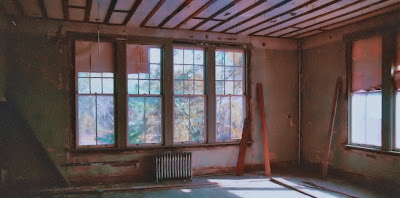
The first step was to remove the old heating radiators

